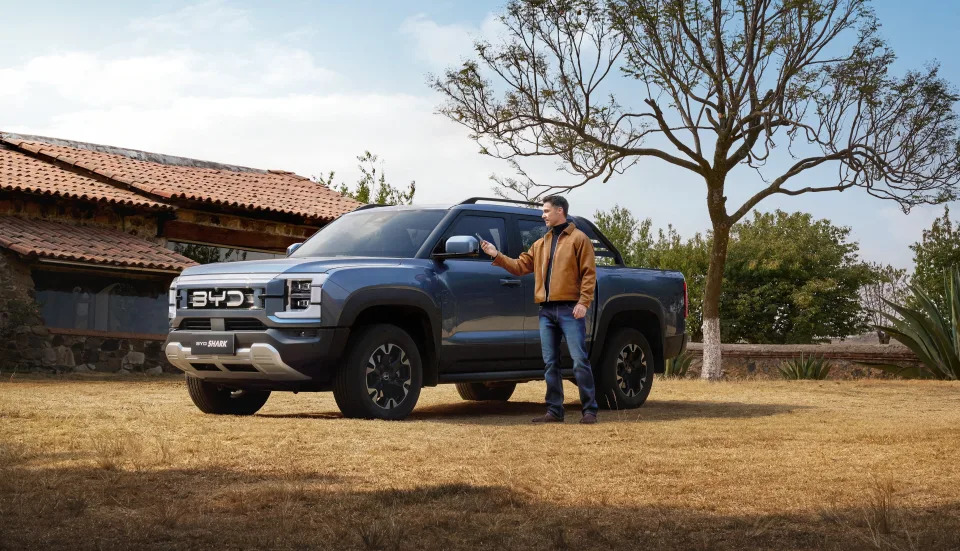
A BYD SharkBYD
OMG! IT LOOKS LIKE A TRUCK
Benjamin Zhang
Wed, May 15, 2024
China's BYD Auto launched its all-new Shark plug-in hybrid pickup truck in Mexico on Tuesday.
The BYD Shark's hybrid drive system puts out 430 horsepower and has 62 miles of all-electric range.
The Shark starts at $54,000 in Mexico but is not for sale in the US.
BYD introduced its new Shark plug-in hybrid pickup truck in Mexico on Tuesday. It's the company's first truck and the first product launched outside its home market, China.
Mexico is growing in importance for BYD's global strategy as it aims to gain a foothold in North America — even as the company has made clear in recent months that it does not plan to enter the US market any time soon.
As a result, the Shark will not be available in the US but will go on sale in Mexico with a starting price of roughly $54,000 USD, or 899,980 pesos.
Therefore, the midsize Shark hybrid will be aimed squarely at major global players like the Toyota Hilux and Nissan Navarra.
In the US, the BYD Shark would have competed against midsize pickup stalwarts like the Toyota Tacoma, Chevrolet Colorado, Nissan Frontier, and Ford Ranger.
However, there are no plug-in hybrid midsize pickup trucks on sale in the US. The Tacoma does offer a hybrid but does not have the ability to be plugged in.
The Shark is built on BYD's Super Hybrid Off-road Platform.
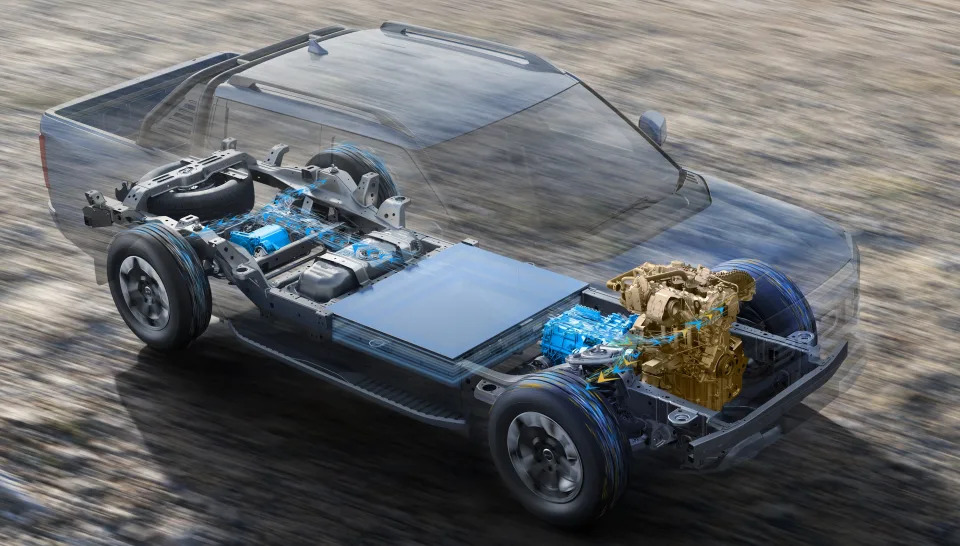
The BYD Shark's hybrid system.BYD
The BYD Sharks' power comes from a longitudinally mounted 1.5-liter, turbocharged four-cylinder engine and two electric drive motors. Together, they produce a total system output of 430hp.
According to BYD, the Shark can make the run from 0-62 mph in just 5.7 seconds
As a result of the hybrid system, the Shark does not have a traditional mechanical all-wheel-drive system.
Instead, it sends power to the rear axle via an electric drive motor.
The Shark comes with a 29.6 kWh battery pack.
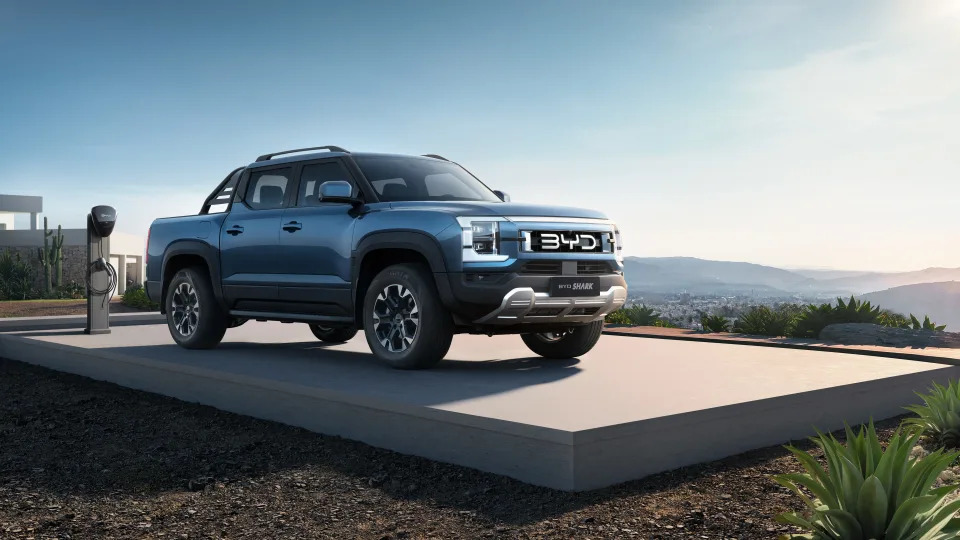
A BYD Shark hybrid pickup truck.BYD
According to BYD, the Shark has an all-electric range of 62 miles. The company also claims the pickup has a maximum combined range of 522 miles with the battery fully charged and a full tank of gas.
According to BYD, the Shark can tow up to 2,500 kg or 5,512 lbs.

A BYD Shark hybrid pickup truck.BYD
Don't expect to do much towing with just the battery, though.
Aesthetically, the Shark's aggressive looks are the work of BYD's design team led by Wolfgang Egger.
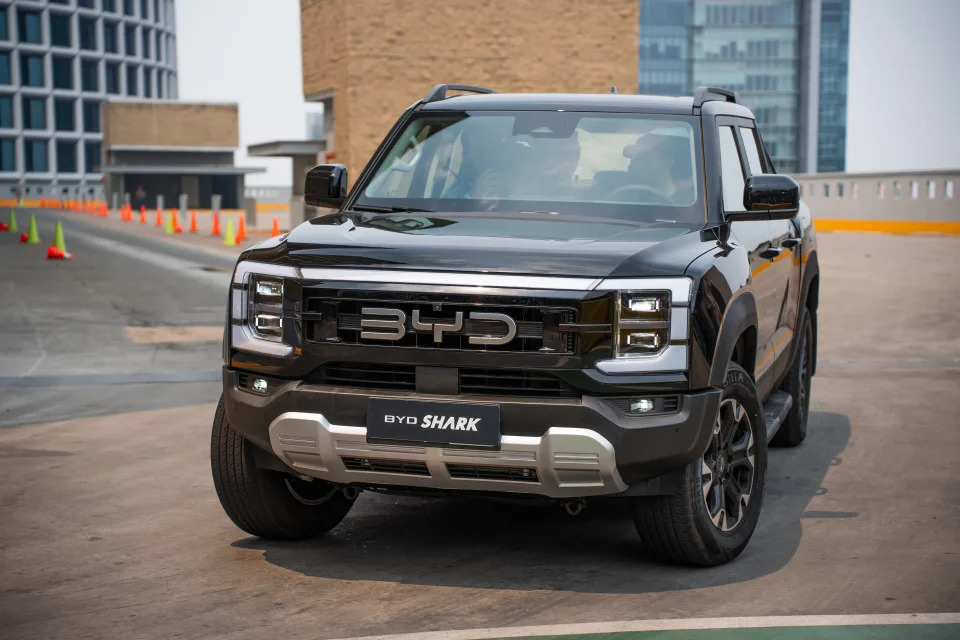
A BYD Shark doing a product demonstration drive at the launch event.BYD
According to BYD, Egger, the former chief designer at Audi and Alfa Romeo, sought inspiration from the aquatic predator for which the truck is named. In fact, the front grille was inspired by the open mouth of a shark.
At 215 inches in length, the Shark is a few inches longer than the Ford Ranger SuperCrew and the standard-wheelbase Nissan Frontier. However, it's about a foot shorter than the extended-length versions of the Frontier and the long-bed Toyota Tacoma.
Inside, the Shark's cabin is highlighted by a head-up display, a 10.25 LCD digital instrument display, and an impressive 12.8-inch central infotainment screen.

The BYD Shark's cabin.BYD
The 12.8-inch screen can change orientation from portrait and landscape. It's also equipped with Apple CarPlay and Android Auto as well as built-in apps for navigation, karaoke and music streaming.
The Shark is also equipped with a 540-degree panoramic view camera.
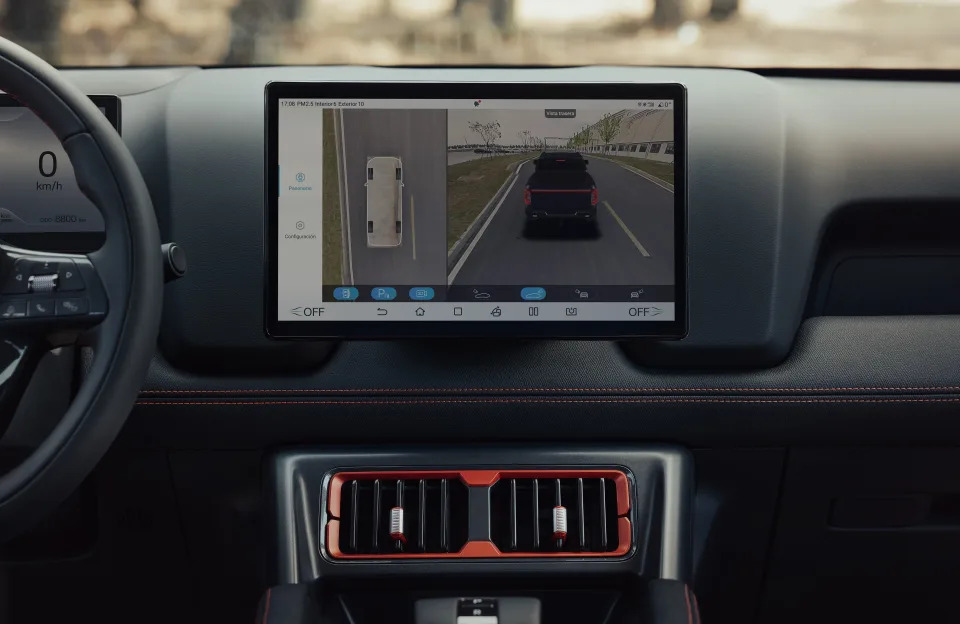
The BYD Shark's 12.8-inch infotainment screenBYD
BYD's 540-degree panoramic camera system is a 360-degree camera coupled with a 180-degree undercarriage view camera. The undercarriage camera is designed to help drivers get a better view of the terrain while offroading.
The Shark comes with a suite of advanced safety features, including adaptive cruise control, lane keep assist, and automatic emergency braking.
Like Tesla's Cybertruck, the Shark's features can be controlled via smartphone which can also serve as a key.

The BYD Shark's digital keyBYD
Tesla has long pioneered the use of its mobile app as an NFC key for vehicles.
The Shark's hybrid system can be used to power campsites or worksites.

The BYD Shark hybrid powers a video projector.BYD
Most electric trucks these days are rife with electrical outlets for the job site or campsite.
Benjamin Zhang
Wed, May 15, 2024
China's BYD Auto launched its all-new Shark plug-in hybrid pickup truck in Mexico on Tuesday.
The BYD Shark's hybrid drive system puts out 430 horsepower and has 62 miles of all-electric range.
The Shark starts at $54,000 in Mexico but is not for sale in the US.
BYD introduced its new Shark plug-in hybrid pickup truck in Mexico on Tuesday. It's the company's first truck and the first product launched outside its home market, China.
Mexico is growing in importance for BYD's global strategy as it aims to gain a foothold in North America — even as the company has made clear in recent months that it does not plan to enter the US market any time soon.
As a result, the Shark will not be available in the US but will go on sale in Mexico with a starting price of roughly $54,000 USD, or 899,980 pesos.
Therefore, the midsize Shark hybrid will be aimed squarely at major global players like the Toyota Hilux and Nissan Navarra.
In the US, the BYD Shark would have competed against midsize pickup stalwarts like the Toyota Tacoma, Chevrolet Colorado, Nissan Frontier, and Ford Ranger.
However, there are no plug-in hybrid midsize pickup trucks on sale in the US. The Tacoma does offer a hybrid but does not have the ability to be plugged in.
The Shark is built on BYD's Super Hybrid Off-road Platform.

The BYD Shark's hybrid system.BYD
The BYD Sharks' power comes from a longitudinally mounted 1.5-liter, turbocharged four-cylinder engine and two electric drive motors. Together, they produce a total system output of 430hp.
According to BYD, the Shark can make the run from 0-62 mph in just 5.7 seconds
As a result of the hybrid system, the Shark does not have a traditional mechanical all-wheel-drive system.
Instead, it sends power to the rear axle via an electric drive motor.
The Shark comes with a 29.6 kWh battery pack.

A BYD Shark hybrid pickup truck.BYD
According to BYD, the Shark has an all-electric range of 62 miles. The company also claims the pickup has a maximum combined range of 522 miles with the battery fully charged and a full tank of gas.
According to BYD, the Shark can tow up to 2,500 kg or 5,512 lbs.

A BYD Shark hybrid pickup truck.BYD
Don't expect to do much towing with just the battery, though.
Aesthetically, the Shark's aggressive looks are the work of BYD's design team led by Wolfgang Egger.

A BYD Shark doing a product demonstration drive at the launch event.BYD
According to BYD, Egger, the former chief designer at Audi and Alfa Romeo, sought inspiration from the aquatic predator for which the truck is named. In fact, the front grille was inspired by the open mouth of a shark.
At 215 inches in length, the Shark is a few inches longer than the Ford Ranger SuperCrew and the standard-wheelbase Nissan Frontier. However, it's about a foot shorter than the extended-length versions of the Frontier and the long-bed Toyota Tacoma.
Inside, the Shark's cabin is highlighted by a head-up display, a 10.25 LCD digital instrument display, and an impressive 12.8-inch central infotainment screen.

The BYD Shark's cabin.BYD
The 12.8-inch screen can change orientation from portrait and landscape. It's also equipped with Apple CarPlay and Android Auto as well as built-in apps for navigation, karaoke and music streaming.
The Shark is also equipped with a 540-degree panoramic view camera.

The BYD Shark's 12.8-inch infotainment screenBYD
BYD's 540-degree panoramic camera system is a 360-degree camera coupled with a 180-degree undercarriage view camera. The undercarriage camera is designed to help drivers get a better view of the terrain while offroading.
The Shark comes with a suite of advanced safety features, including adaptive cruise control, lane keep assist, and automatic emergency braking.
Like Tesla's Cybertruck, the Shark's features can be controlled via smartphone which can also serve as a key.

The BYD Shark's digital keyBYD
Tesla has long pioneered the use of its mobile app as an NFC key for vehicles.
The Shark's hybrid system can be used to power campsites or worksites.

The BYD Shark hybrid powers a video projector.BYD
Most electric trucks these days are rife with electrical outlets for the job site or campsite.
The incredible rise of Chinese Tesla rival BYD, which just unveiled a Cybertruck competitor
Camilo Fonseca,Ana Altchek
Wed, May 15, 2024

The Seal U is one of BYD's latest electric-vehicle offerings.Anusak Laowilas/NurPhoto via Getty Images
The Chinese automaker BYD briefly eclipsed Tesla as the world's top seller of electric vehicles.
Even though it doesn't have access to the US market, BYD's affordable EVs are popular in China.
Here's how a little-known Chinese brand proved it could go toe-to-toe with an industry giant.
BYD may not be a household name in America, but it recently made itself known in a big way.
For a brief moment earlier this year, the Chinese automaker unseated Tesla as the world's top seller of electric cars.
Even though you won't see a BYD car in America (yet), the company has built an affordable brand that's popular in China and elsewhere.
ADVERTISEMENT
It also just announced a Cybertruck competitor, the BYD Shark.
Here's the story of the company that proved it could outsell Elon Musk.
BYD doesn't stand for anything — officially.

The BYD nameplate is associated with the slogan "Build Your Dreams," but that came after the company was formed.picture alliance
Wang Chuanfu and a cousin founded BYD in 1995. Then a 29-year-old government researcher, Wang came from a family of rice farmers. He earned a university scholarship and eventually moved to the Special Economic Zone in Shenzhen to start his new company.
The "YD" in the name came from Yadi, the village in Shenzhen where the company originally was, one South Korean newspaper reported. The "B" was added later as a promotional tool, the report said. Wang has said in interviews that, taken together, the BYD name doesn't stand for anything in particular.
It was only later that Wang derived the slogan "Build Your Dreams." The company has also acquired another nickname: "Bring Your Dollars."
The company was originally a cellphone-battery manufacturer.
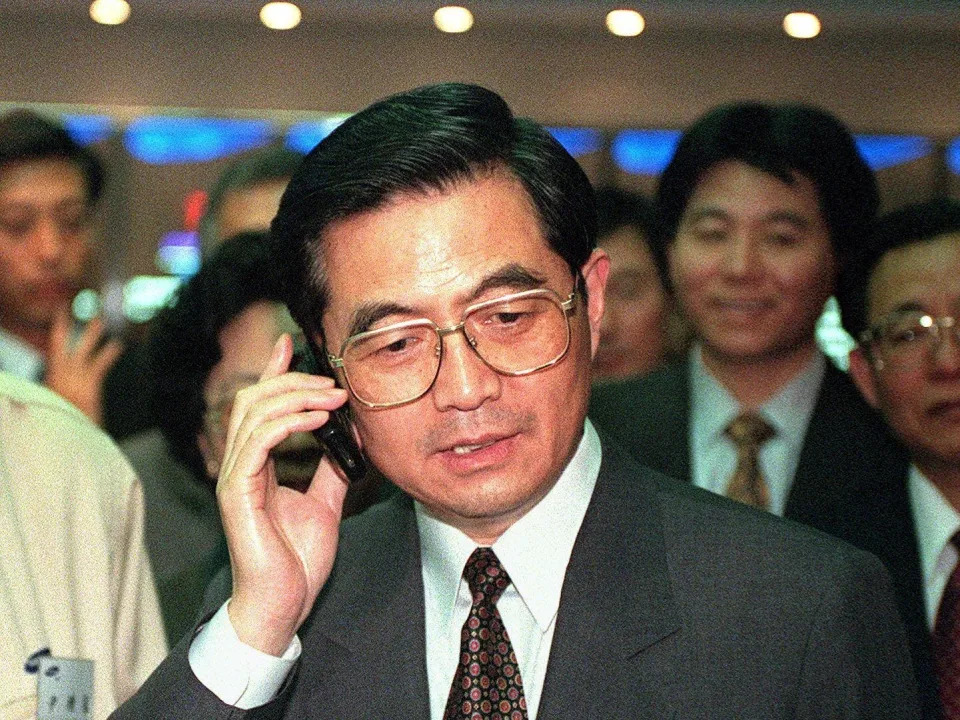
Chinese Vice President Hu Jintao testing a Samsung cellphone in the 1990s. Samsung was one of BYD's earliest customers.Kim Jae-Hwang/AFP via Getty Images
The company's original business wasn't cars. It was cellphone batteries. BYD challenged the established Japanese suppliers Toyota and Sony by providing a cheaper alternative. By 2002, companies such as Motorola, Nokia, Sony Ericsson, and Samsung were all using BYD batteries.
They started making cars in 2003.

A BYD F3DM.Peter Parks/AFP via Getty Images
BYD moved into the car business after buying Xi'an Tsinchuan, a failing state-owned automaker that was then an arm of the defense contractor Norinco, the South China Morning Post reported.
The company launched its first car in 2005. The BYD F3 was a compact sedan that resembled the Toyota Corolla. It sold for as little as 40,000 yuan, or about $5,850.
Warren Buffett was a key early booster.
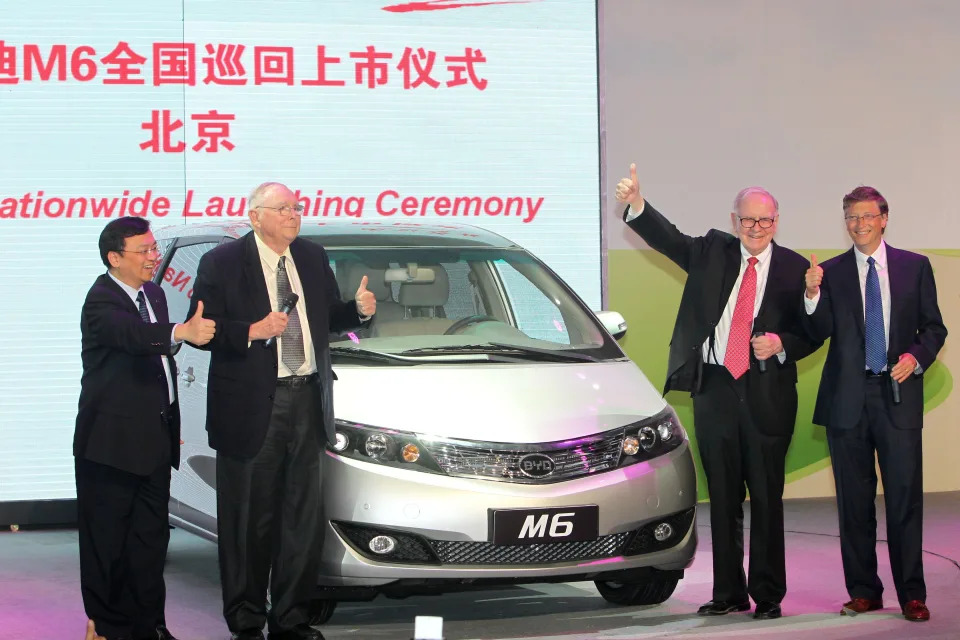
Wang Chuanfu welcomed the investors Charlie Munger, Warren Buffett, and Bill Gates to celebrate the launch of the BYD M6 in 2010.Visual China Group via Getty Images
The billionaire investor Warren Buffett was one of the high-profile names who took an interest in BYD early on. Looking to invest in China's booming car market, Buffett toured BYD's headquarters.
The Wall Street Journal reported that while the Berkshire Hathaway tycoon was there, Wang took a sip of battery fluid to prove how clean his batteries were. Buffett was so impressed by the experience that he offered to buy 25% of the company.
Wang declined that offer, but Buffett was not deterred. Berkshire Hathaway acquired a 10% stake in BYD — for $232 million — in 2008.
Their first electric car drew scorn from Elon Musk.

A BYD E6.Stan Honda/AFP via Getty Images
The company debuted its first fully electric vehicle, the E6, in 2010. Benefiting from Chinese government subsidies, it was able to compete with its Japanese counterparts.
But not everyone was impressed. Tesla CEO Elon Musk laughed in a 2011 interview when asked whether he considered BYD a serious rival to Tesla.
"Have you seen their car?" he said. "I don't think they make a good product. I don't think it's particularly attractive. The technology is not very strong."
BYD's hybrid cars turned it into a titan of Chinese automakers.

Chuanfu introduced the BYD Qin in 2012.AP Photo/Alexander F. Yuan
BYD established itself as one of the top automakers for hybrid vehicles in China in the 2010s. Its most popular offering was the Qin, introduced in 2012, which became one of the best-selling cars in China.
That wasn't the only offering that propelled BYD to prominence, however. The company also released the Tang, a hybrid SUV, and partnered with Daimler AG (now Mercedes-Benz) to make its Denza line.
BYD took the EV crown from Tesla — briefly.

A BYD Atto 3.Athit Perawongmetha/Reuters
Even though most of its sales in the fourth quarter of 2023 came from the Chinese market, BYD made headlines across the globe when it seemingly did the impossible — it unseated Tesla as the world's top seller of electric cars.
The Chinese automaker rode the EV wave on the back of its new Seagull, which debuted for 73,000 yuan, or about $10,000, as well as its Song, Qin Plus, Dolphin, Yuan Plus, and Han EVs.
Tesla reclaimed the crown in the first quarter of 2024, though both companies saw steep declines in their sales.
BYD's Shark takes aim at Tesla's Cybertruck
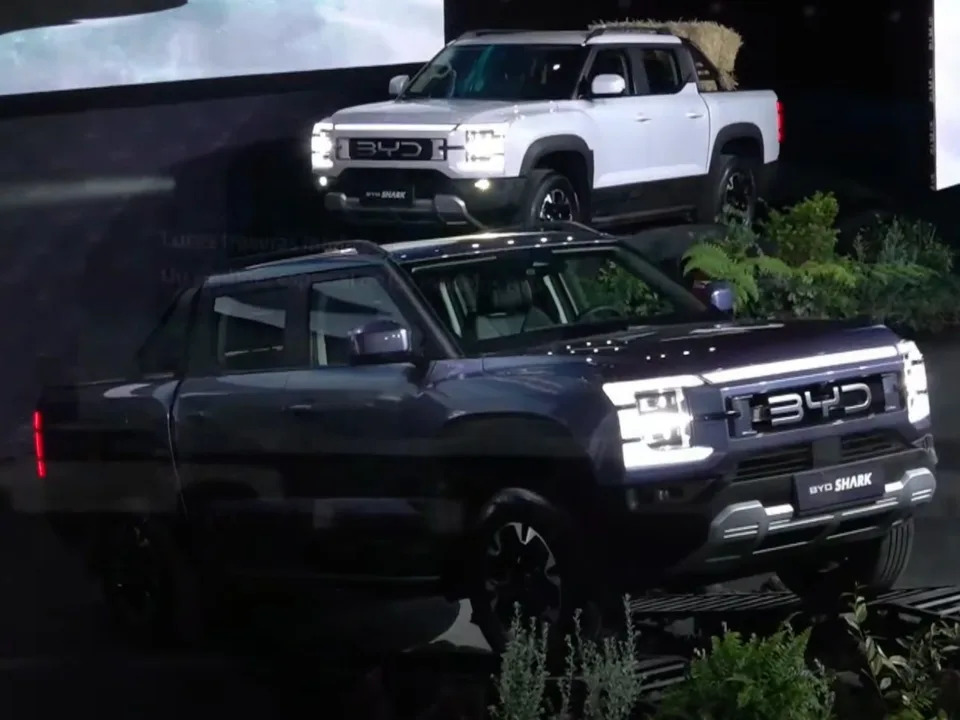
The BYD Shark is supposed to represent an actual shark, according to the launch event. BYD Auto México
The Shark, unveiled on Tuesday, is the latest model offered by BYD.
It's a midsize hybrid pickup truck, and the cabin's design fuses outdoor functionality with modern style and durability.
The truck has more than 430 horsepower, or 170 less than Tesla's all-wheel-drive Cybertruc. BYD says it can accelerate from zero to 100 kilometers an hour, or about 62 miles an hour, in roughly 5.7 seconds. The vehicle has five seats and a maximum towing capacity of 2,500 kilograms, which is just more than 5,500 pounds. That's about half of the Cybertruck's towing capability.
Designed for everyday trips and off-road driving, the Shark has three terrain modes: sand, mud, and snow.
It also has built-in features to make camping and off-roading more accessible. The vehicle offers bidirectional charging, according to BYD's site.
While the Shark isn't in direct competition with the Cybertruck as a hybrid model that doesn't sell in the US, it may entice EV fans looking for a more traditional pickup design. It's also priced competitively at about $53,451, which is lower than Cybertruck's $60,990 starting price tag.
Don't expect to see a BYD car on American roads anytime soon.
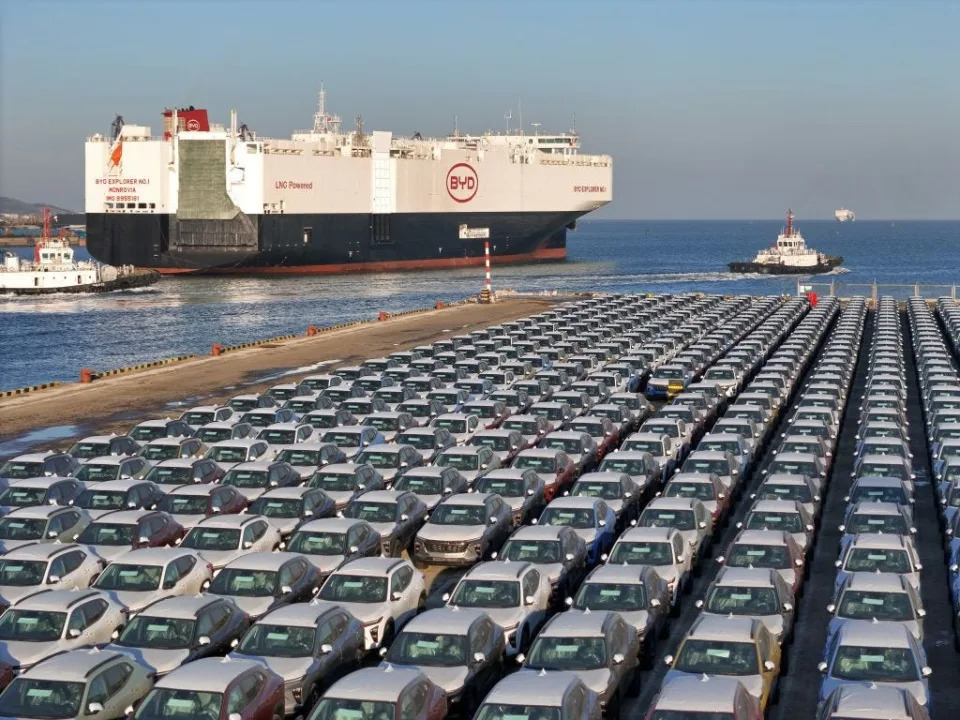
New BYD cars waiting to be loaded onto a ship in China's Shandong province.
Camilo Fonseca,Ana Altchek
Wed, May 15, 2024

The Seal U is one of BYD's latest electric-vehicle offerings.Anusak Laowilas/NurPhoto via Getty Images
The Chinese automaker BYD briefly eclipsed Tesla as the world's top seller of electric vehicles.
Even though it doesn't have access to the US market, BYD's affordable EVs are popular in China.
Here's how a little-known Chinese brand proved it could go toe-to-toe with an industry giant.
BYD may not be a household name in America, but it recently made itself known in a big way.
For a brief moment earlier this year, the Chinese automaker unseated Tesla as the world's top seller of electric cars.
Even though you won't see a BYD car in America (yet), the company has built an affordable brand that's popular in China and elsewhere.
ADVERTISEMENT
It also just announced a Cybertruck competitor, the BYD Shark.
Here's the story of the company that proved it could outsell Elon Musk.
BYD doesn't stand for anything — officially.

The BYD nameplate is associated with the slogan "Build Your Dreams," but that came after the company was formed.picture alliance
Wang Chuanfu and a cousin founded BYD in 1995. Then a 29-year-old government researcher, Wang came from a family of rice farmers. He earned a university scholarship and eventually moved to the Special Economic Zone in Shenzhen to start his new company.
The "YD" in the name came from Yadi, the village in Shenzhen where the company originally was, one South Korean newspaper reported. The "B" was added later as a promotional tool, the report said. Wang has said in interviews that, taken together, the BYD name doesn't stand for anything in particular.
It was only later that Wang derived the slogan "Build Your Dreams." The company has also acquired another nickname: "Bring Your Dollars."
The company was originally a cellphone-battery manufacturer.

Chinese Vice President Hu Jintao testing a Samsung cellphone in the 1990s. Samsung was one of BYD's earliest customers.Kim Jae-Hwang/AFP via Getty Images
The company's original business wasn't cars. It was cellphone batteries. BYD challenged the established Japanese suppliers Toyota and Sony by providing a cheaper alternative. By 2002, companies such as Motorola, Nokia, Sony Ericsson, and Samsung were all using BYD batteries.
They started making cars in 2003.

A BYD F3DM.Peter Parks/AFP via Getty Images
BYD moved into the car business after buying Xi'an Tsinchuan, a failing state-owned automaker that was then an arm of the defense contractor Norinco, the South China Morning Post reported.
The company launched its first car in 2005. The BYD F3 was a compact sedan that resembled the Toyota Corolla. It sold for as little as 40,000 yuan, or about $5,850.
Warren Buffett was a key early booster.

Wang Chuanfu welcomed the investors Charlie Munger, Warren Buffett, and Bill Gates to celebrate the launch of the BYD M6 in 2010.Visual China Group via Getty Images
The billionaire investor Warren Buffett was one of the high-profile names who took an interest in BYD early on. Looking to invest in China's booming car market, Buffett toured BYD's headquarters.
The Wall Street Journal reported that while the Berkshire Hathaway tycoon was there, Wang took a sip of battery fluid to prove how clean his batteries were. Buffett was so impressed by the experience that he offered to buy 25% of the company.
Wang declined that offer, but Buffett was not deterred. Berkshire Hathaway acquired a 10% stake in BYD — for $232 million — in 2008.
Their first electric car drew scorn from Elon Musk.

A BYD E6.Stan Honda/AFP via Getty Images
The company debuted its first fully electric vehicle, the E6, in 2010. Benefiting from Chinese government subsidies, it was able to compete with its Japanese counterparts.
But not everyone was impressed. Tesla CEO Elon Musk laughed in a 2011 interview when asked whether he considered BYD a serious rival to Tesla.
"Have you seen their car?" he said. "I don't think they make a good product. I don't think it's particularly attractive. The technology is not very strong."
BYD's hybrid cars turned it into a titan of Chinese automakers.

Chuanfu introduced the BYD Qin in 2012.AP Photo/Alexander F. Yuan
BYD established itself as one of the top automakers for hybrid vehicles in China in the 2010s. Its most popular offering was the Qin, introduced in 2012, which became one of the best-selling cars in China.
That wasn't the only offering that propelled BYD to prominence, however. The company also released the Tang, a hybrid SUV, and partnered with Daimler AG (now Mercedes-Benz) to make its Denza line.
BYD took the EV crown from Tesla — briefly.

A BYD Atto 3.Athit Perawongmetha/Reuters
Even though most of its sales in the fourth quarter of 2023 came from the Chinese market, BYD made headlines across the globe when it seemingly did the impossible — it unseated Tesla as the world's top seller of electric cars.
The Chinese automaker rode the EV wave on the back of its new Seagull, which debuted for 73,000 yuan, or about $10,000, as well as its Song, Qin Plus, Dolphin, Yuan Plus, and Han EVs.
Tesla reclaimed the crown in the first quarter of 2024, though both companies saw steep declines in their sales.
BYD's Shark takes aim at Tesla's Cybertruck

The BYD Shark is supposed to represent an actual shark, according to the launch event. BYD Auto México
The Shark, unveiled on Tuesday, is the latest model offered by BYD.
It's a midsize hybrid pickup truck, and the cabin's design fuses outdoor functionality with modern style and durability.
The truck has more than 430 horsepower, or 170 less than Tesla's all-wheel-drive Cybertruc. BYD says it can accelerate from zero to 100 kilometers an hour, or about 62 miles an hour, in roughly 5.7 seconds. The vehicle has five seats and a maximum towing capacity of 2,500 kilograms, which is just more than 5,500 pounds. That's about half of the Cybertruck's towing capability.
Designed for everyday trips and off-road driving, the Shark has three terrain modes: sand, mud, and snow.
It also has built-in features to make camping and off-roading more accessible. The vehicle offers bidirectional charging, according to BYD's site.
While the Shark isn't in direct competition with the Cybertruck as a hybrid model that doesn't sell in the US, it may entice EV fans looking for a more traditional pickup design. It's also priced competitively at about $53,451, which is lower than Cybertruck's $60,990 starting price tag.
Don't expect to see a BYD car on American roads anytime soon.

New BYD cars waiting to be loaded onto a ship in China's Shandong province.
Future Publishing
For a time, it looked as if we were just a few years away from getting Chinese electric cars in the United States. A BYD executive said as much in 2017, and the company even hired Leonardo DiCaprio as a brand ambassador for English-speaking customers.
Since then, BYD has expanded overseas. The Chinese automaker is planning a factory in Mexico — alarming US officials — and even created its own shipping fleet in a bid to cut down on export costs.
But the company says it has abandoned its plans of selling its EVs to Americans. Analysts have pointed to geopolitical tensions and trade barriers between the two countries, as well as the slumping demand for EVs in the United States.
For a time, it looked as if we were just a few years away from getting Chinese electric cars in the United States. A BYD executive said as much in 2017, and the company even hired Leonardo DiCaprio as a brand ambassador for English-speaking customers.
Since then, BYD has expanded overseas. The Chinese automaker is planning a factory in Mexico — alarming US officials — and even created its own shipping fleet in a bid to cut down on export costs.
But the company says it has abandoned its plans of selling its EVs to Americans. Analysts have pointed to geopolitical tensions and trade barriers between the two countries, as well as the slumping demand for EVs in the United States.
No comments:
Post a Comment